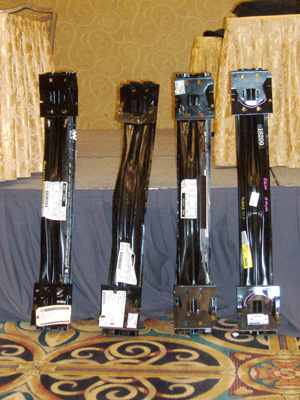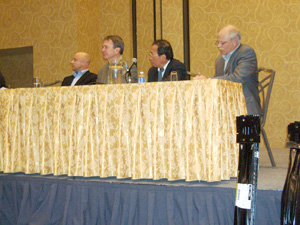The ongoing aftermarket-OEM parts debate continued at the Collision Industry Conference (CIC) held Nov. 3 at the SEMA show in Las Vegas, with Ford Motor Company concluding as the result of crash tests it conducted that using aftermarket bumpers can negatively impact airbag deployment.
Ford was prompted to conduct the crash tests as the result of requests for more information on airbag deployment after its last presentation at the July CIC held in Chicago.
The tests were conducted on Oct. 6 and Oct. 19-20. Two like 2007 Ford Mustangs were outfitted with an OEM bumper beam and an aftermarket bumper beam and then crashed into a rigid barrier at 5 mph and 8 mph.
Ford engineer Roger Chen prefaced his comments by saying that Ford was no stranger to testing, given its “rigorous” crash testing efforts to meet its own safety requirements and those of the Insurance Institute for Highway Safety (IIHS) and regulatory guidelines. There are multiple tests conducted at different speeds against different types of barriers.
“You have to pass all these tests, and if you fail just one, you have to start the process all over again,” Chen said.
Energy Absorption
In regard to the Ford Mustang test using OEM and aftermarket bumpers, the results, Chen said, highlighted the significant difference between the OEM and aftermarket parts.
“The OE bumper rebounded much faster and absorbed more energy before rebounding,” said Chen. “The aftermarket bumper bottomed out against the fixture.”
“When you look at velocity trace versus time, the deceleration of the OE part was much faster than the aftermarket part,” Chen continued. “Also, consider that with the aftermarket beam, you also had an aftermarket absorber made of polystyrene and an aftermarket isolator. The stacking up of these parts changed the crash characteristics of the entire bumper assembly, which is why [Ford] advocates more than just component level crash testing but also system level testing.
“The front rails were still good on the OEM vehicle, but the rails on the aftermarket vehicle were bent after the 8-mph test. We showed you with videos and data in July that aftermarket bumpers resulted in more intrusion into the vehicle.”
After each crash, the parts that had broken were removed and replaced with new OEM and aftermarket parts. At 5 mph, a headlight was broken on the aftermarket vehicle, which was replaced with a new OEM light. According to Paul Massie, powertrain and collision product marketing manager for Ford, after the 8-mph crash, there was still some space between the OEM bumper and the condenser but less space between the aftermarket bumper and condenser. However, Massie said in both the OEM and aftermarket 8-mph crashes, the condensers had to be replaced because the horn got pushed back and compressed the fins.
Estimating the Cost
Ford also had an estimator write two estimates for each crash, based on both OEM and aftermarket parts and prices. The result, Massie claimed, was that both 5-mph and 8-mph crash tests of aftermarket bumpers revealed much higher repair costs – with the 5-mph aftermarket crash costing more than double the OEM crash.
“The biggest difference in the 5-mph crash was that, in the aftermarket vehicle, the hood had to be replaced and one light broke,” said Massie. “In the 8-mph crash, two lights on the OE car were damaged and only one on the aftermarket car. But the one on the aftermarket car that didn’t break was the light that broke at 5 mph and was replaced with a new OE light. And the other three lights that did break had already had two hits on them. If the airbags had deployed on the aftermarket vehicle when they shouldn’t have, there would have been additional expenses.”
Chen also covered a chart that revealed that the majority of accidents, with injuries, occur at speeds of less than the 35-mph government test. The safety and sensor system is designed for both high- and low-speed accidents, where the bumper beam, Chen said, is a critical component in the safety systems.
Airbag Sensors
David Bauch, also a Ford engineer, explained that the crash testing Ford conducts creates data that is used to calibrate airbag sensors.
“Sensors look at the acceleration data and make a decision to predict when you want the airbag deployed,” Bauch said.
His conclusions were:
1) Crash energy absorbed by the aftermarket bumper beam is less than the crash energy absorbed by the OEM bumper beam.
2) Airbag deployments at low speeds will increase with the aftermarket bumper beam, absorber and isolator. The aftermarket bumper beam will change the pulse created in crash modes that the crash sensors use for deployment of an airbag, and in crash events where the airbag is not required to be deployed.
Massie concluded the presentation by saying that Ford would supply the National Highway Traffic Safety Administration with this new crash test data.
“We will continue to work with industry trades, automobile alliances and the government to see what can be done about oversight of aftermarket parts,” he said.
The Audience Speaks
Karen Fierst, a former consultant for the Taiwan Auto Body Parts Association (TABPA), expressed her satisfaction with all of the actions that have been taken since I-CAR instructor Toby Chess’s controversial presentation at the January 2010 CIC.
“Toby’s action caused the Automotive Body Parts Association (ABPA), TABPA distributors and Taiwan manufacturers to ask their membership to cease and desist the sale of these products until certified,” Fierst said. “And until today, CAPA did not have a certification standard for these types of parts. Also, an NSF standard was announced in February or March, and within the last month has now certified some parts. This is all good for the industry and the consumer.
“But after having been in the aftermarket sector for 20 years, I find it interesting that the car manufacturers have now jumped on this issue to this extent. I think it’s great, but what it says to me is that the standards that are out there are working. Because if they were not working, the car manufacturers would have been coming to CIC for the past 15 years and doing presentations like these.”
Massie then explained why Ford acted only recently.
“First, Ford was sitting in the room when Toby did his presentation,” he said. “Then, press releases followed on what the aftermarket and insurance companies were going to do, and long-term, we felt we could be held complicit if we did nothing.
“Why hasn’t this been an issue for 20 years? More automakers are moving into more ultra high strength steels, and while the aftermarket has typically focused on cosmetic serial parts, it’s a changing world, and we felt we needed to address the yearning from audience members who were asking, ‘Okay, Mr. OE, what about this?’”
Rick Sherwood, owner of Detroit-based consulting firm OEM Collision Repair Resources, claimed Fierst had her history wrong about automakers not getting involved in parts quality discussions until recently.
“You may recall that Ford tested a panoply of aftermarket parts in 1994, which led to the Avery decision, which in essence stopped insurers from using aftermarket parts,” Sherwood said. “It has been a continuation because the collision repair industry has said these parts are not equivalent and don’t fit and no one has listened. Maybe now someone will start listening and the problem will be rectified.”
Greg Bayley, representing ABPA, then questioned the findings of Ford’s crash tests, claiming that bumpers take much less of a percentage of energy absorption in high-speed crashes and therefore won’t make much of a difference. Ford engineer Chen then explained why the tests were conducted at the lower speeds.
“I agree that energy absorption in a high-speed crash of 35 mph will be in the low range for bumper contribution, perhaps 5 percent or less, but what we’re talking about here are the low-speed crashes where injury frequency is occurring – between the ranges of 10, 15, 20 and 40 mph,” said Chen.
Bayley responded, “The injury criteria at those loads are representative of Ford Motor Co., which used to tout you could survive up to a 35-mph barrier crash without any restraint system.”
Chen responded, “You’re probably referring to the 1980s, when restraint systems were not that advanced yet. Today’s restraint system is very, very complicated. We have to pass tests for high deployment first mode in first stage, then second stage, and those conditions are most present in this speed range. And in that range, you’re going to alter the timing of the deployment and change the way the impacting sensor performs and also have injury potential.”
In response to one audience member wondering, now that NSF has come up with its own standard, if having too many disparate standards is a good or bad thing, Dan Morrissey of ABPA said he believes it’s good.
“Certification programs are needed so shops can tell the difference between high quality and low quality aftermarket parts,” Morrissey said. “As a distributor, I feel multiple certification programs are good. Chrome bumper and reinforcement bar certification would never have come this far with the CAPA standard unless NSF came along to create some competition. Approximately 20 percent of parts that are certifiable are sold as CAPA certified, and we as an industry want to raise that number but it has been stuck there for a long time. The only thing that will get more certified crash parts available is some competition.”

More information:
Ford Unveils Results of Crash Part Testing at CIC
CAPA Releases New Bumper Standard, Enlists IIHS for Crash Tests
Diamond Standard Says Study Indicates ‘Acceptable Variance’ Among Parts Exists
NSF Certifies Reinforcement Bars as Part of Automotive Aftermarket Parts Certification Program
Crash Parts Controversy Makes USA Today
Consumer Reports Warns Public About Aftermarket Parts; ABPA Responds
California Congresswoman Uses Reciprocating Saw to Test Differences Between Bumper Rebars













